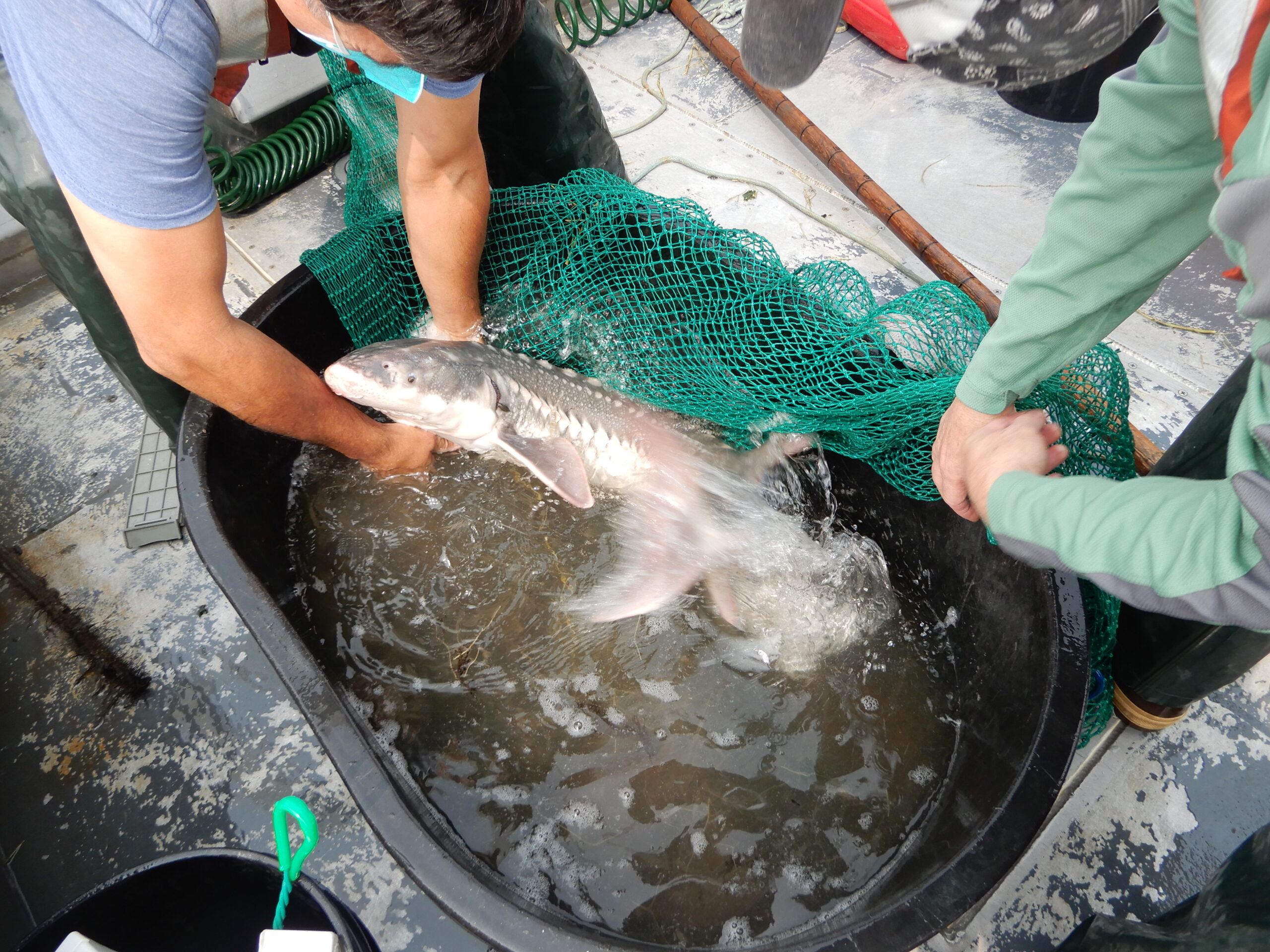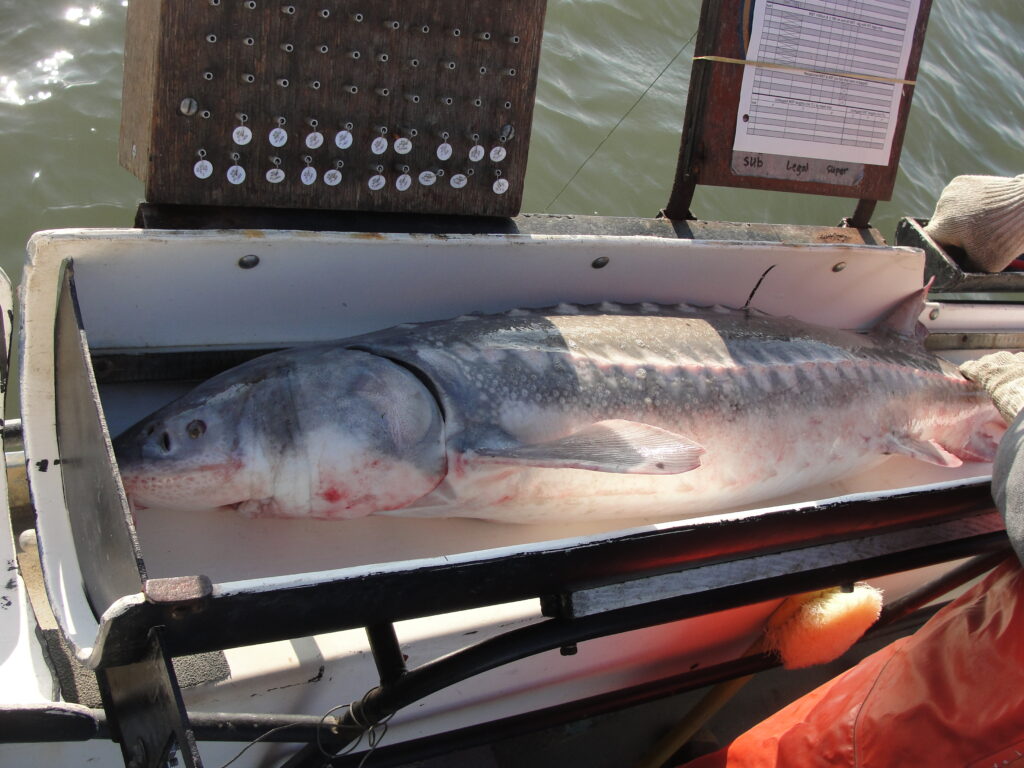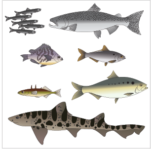
A 90-year-old Australian lungfish at San Francisco’s Academy of Sciences has received a lot of press lately, but there is a wild fish species living in the San Francisco Bay that has the potential to live that long or longer — or so we think.
While one white sturgeon caught in the Columbia River Basin was estimated to be 104 years old, the life expectancy of white sturgeon, Acipenser transmontanus, which includes the Central Valley population endemic to the San Francisco Bay, is hard to pin down. “There are old ones out there, but it’s really hard to give a number because we just don’t have it,” says John Kelly, statewide sturgeon coordinator for the California Department of Fish and Wildlife (CDFW).
Sturgeon are often referred to as living fossils. Armored with bony scutes, not scales, they have been swimming in global river systems since before T-Rex. Of the 27 extant sturgeon species in the world, those in the Bay (and other self-sustaining populations in Oregon and Washington) are doing the best. “There are two sturgeon species in the estuary, which are managing to maintain populations despite everything,” says UC Davis distinguished professor emeritus Peter Moyle. “Most species of sturgeon around the world are headed for extinction in the short term.”
The two sturgeon species that rely on the San Francisco Bay watershed for their survival are the white sturgeon and the green sturgeon, Acipenser medirostris. The latter, listed as threatened under the federal Endangered Species Act, spends most of its life in coastal Pacific Ocean waters from Ensenada, Mexico to the Bering Sea, except for when it spawns in large rivers, like the Sacramento, and feeds in the Bay in summer.
White sturgeon is the larger and longer-lived of the two species. White sturgeon can reach 20 feet in length and weigh more than 1,000 pounds. Except for the occasional wanderer, white sturgeon spend their entire lives in Suisun and San Pablo bays apart from spawning every few years, primarily in the Sacramento River. Biologists estimate that between 30,000 and 56,000 white sturgeon within the legal size limit (40 to 60 inches from the tip of the snout to the fork in the tail) reside in the Bay. Elsewhere on the West Coast, there are also self-sustaining populations in the Fraser, Columbia, Snake, and Kootenai rivers.
Although it is possible for white sturgeon to be centenarians, it’s difficult to determine their age, let alone their life expectancy. One of the ways to ascertain a sturgeon’s age is to bisect its otolith, a smaller-than-marble-sized bone in their ear that helps them detect sound waves and maintain balance. While scientists can count the growth rings in this bone, the only way to obtain it is from a dead fish. “We don’t want to be killing fish just to find out how old they are,” Kelly says.
Another way to determine age is to remove a one-centimeter segment of the pectoral fin ray and look for growth rings in that slice. But this works best for fish younger than 30 because as the fish age, the rings grow closer together and become harder to read.
“Sturgeon are always kind of cryptic. They’re just tough to study,” says Kelly. The information obtained by annual CDFW monitoring that includes three months of catching, measuring, and tagging, is skewed by the size of the nets the scientists use to capture the fish, he notes. “We don’t catch a lot of smaller fish or the very, very big fish. There’s a huge risk of injuring those big fish, so we really try to focus our efforts on the fish targeted in the fishery,” those that are 40 to 60 inches long, and for the most part no more than 20 years old.

White sturgeon lived in the Bay for thousands of years before the California Board of Fish Commissioners reported on their status at the end of the 19th century. An 1880 Commission report said that sturgeon, some recorded as reaching 12 feet in length and weighing 600 pounds, were so plentiful that the meat was cheap and appeared on menus as “steak of sole.”
Just ten years later, sturgeon became one of the highest-priced fish in markets due to low catches. In 1901, the Fish Commission prohibited all sturgeon fishing to allow the species to recover — but it didn’t. In 1917 they closed the fishery. “The State has seen the commercial extinction of the sturgeon,” a report read.
The Commission reopened recreational sturgeon fishing in 1954, and for many years, an angler could take a fish a day with no annual limit. Restrictions tightened, and today an angler is allowed one fish a day, but with a limit of three per year. Anglers are required to fill out sturgeon report cards and tag all harvested white sturgeon. Poaching, the illegal take of female white sturgeon for its valuable black caviar, is a challenging problem for wildlife officers.
As for their life expectancy, while they may have the potential to live 100 years, they likely are not. “It’s not a biological change, but risk exposure,” says CDFW’s Kelly. “It’s simply that there are things preventing them from surviving.”
Consider an 80-year-old white sturgeon in the Bay today, says Kelly, one that would have been born in 1940. By the time it matured 14 years later, the recreational fishery had reopened with no annual limits, and the era of big-dam building was in full swing, reducing habitat and changing flows. Added to these threats were fertilizers, PCBs, and selenium in the water. “That old fish would’ve had to go through a lot to still be here.”
While our local white sturgeon are doing better than other populations around the world, their numbers are lower than what they once were, and they need our protection. CDFW recommends that help come via reductions in pollution and chemicals in the water, improvements to habitat and stream flows, and more resources to deter poachers and those who buy illegal caviar. Perhaps then we can help our sturgeon live up to their life expectancy potential.
Top photo: Small white sturgeon caught in a recent otter trawl of the South Bay fish survey, and later returned to the water. Photo: James Ervin
Previous Estuary Stories
